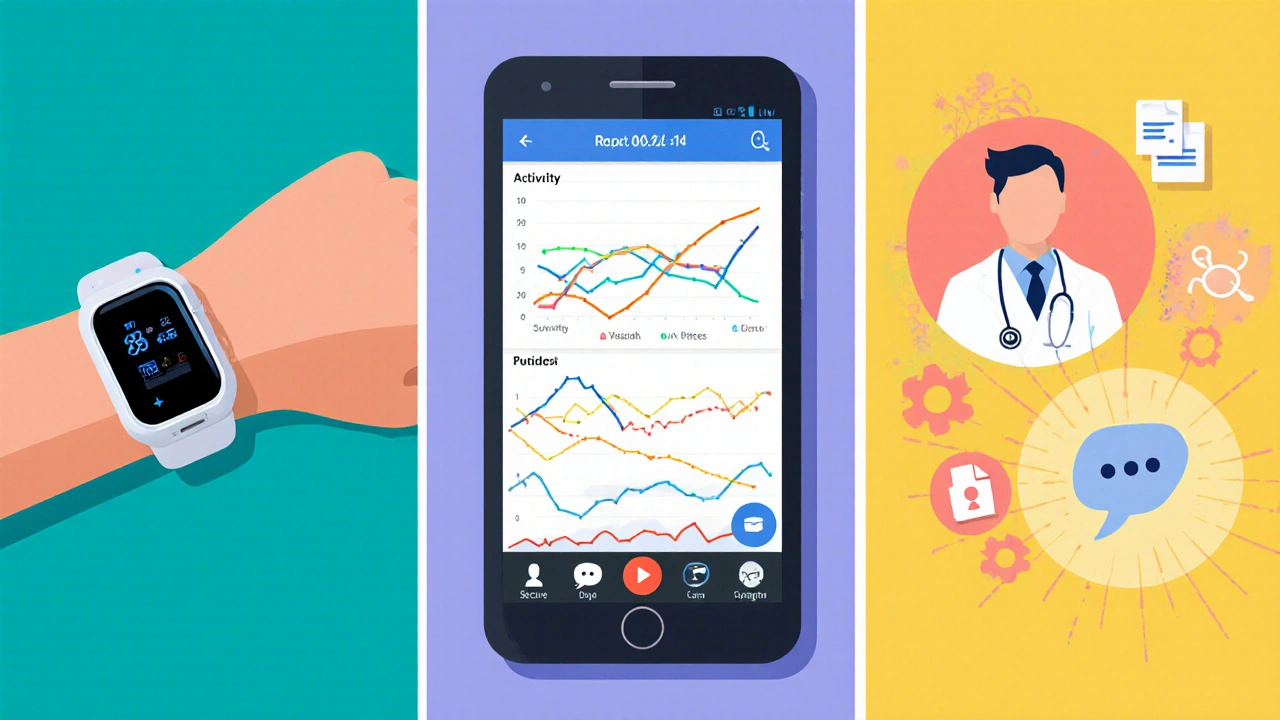Relapsing-Remitting Disease Management Toolkit
Recommended Tools for Your Situation
Modern technology offers powerful tools to anticipate, track, and respond to disease flares in real time. Here's what each tool does:
- Wearables: Track vital signs and movement to detect early warning signs
- Health Apps: Log symptoms and medication to identify patterns
- Telemedicine: Enable remote consultations to reduce travel burden
- AI Platforms: Predict flare-ups before symptoms appear
- EHR Integration: Centralize all health data for better clinical decisions
Living with a relapsing‑remitting disease can feel like riding a roller coaster you never signed up for. One day you’re cruising, the next you’re stuck in an unexpected flare‑up. technology in disease management is changing that ride, giving patients and clinicians tools to anticipate, track, and respond to the ups and downs in real time.
Key Takeaways
- Wearable sensors and health‑apps provide continuous data that helps spot early signs of a relapse.
- Telemedicine lets you stay connected with specialists without the hassle of travel.
- AI‑driven platforms can predict flare patterns and suggest personalized interventions.
- Integrating tech with your care plan requires a clear goal, a trusted device, and regular data reviews.
- Future trends like digital twins and remote drug delivery promise even tighter disease control.
What Is a Relapsing‑Remitting Disease?
Relapsing‑Remitting Disease is a medical condition characterized by periods of symptom flare‑ups followed by phases of partial or complete remission. The most well‑known example is Multiple Sclerosis (an autoimmune disease affecting the central nervous system), but the pattern also shows up in Inflammatory Bowel Disease (including Crohn’s disease and ulcerative colitis), rheumatoid arthritis, and certain skin conditions. The unpredictable nature makes day‑to‑day planning tricky, which is why precise monitoring matters.
Why Technology Matters
Traditional care relies on clinic visits every few months, a timeline that often misses the early warning signs of a flare. Modern tech fills that gap in three ways:
- Continuous data capture: Sensors on your wrist or phone log heart rate, sleep quality, activity levels, and even skin temperature.
- Instant communication: Secure messaging and video calls let you share data with your neurologist or gastroenterologist as soon as something looks off.
- Predictive analytics: Machine‑learning models scan patterns across dozens of data points to forecast a relapse weeks before symptoms appear.
When you combine these pieces, the disease becomes something you can anticipate rather than simply react to.

Core Tech Tools for Daily Management
Here’s the toolbox most patients end up using:
- Wearable Devices (gadgets like smartwatches or dedicated medical sensors that track vitals and movement) - Think of them as a silent companion that records how you feel before you even notice a change.
- Mobile Health Apps (software on your phone that logs symptoms, medication, and lifestyle factors) - Popular options include MyMS, Crohn’s Tracker, and generic symptom diaries.
- Telemedicine Platforms (secure video‑call services that connect patients with specialists remotely) - These eliminate the need for a 2‑hour drive when a flare pops up.
- Artificial Intelligence (algorithms that analyze longitudinal data to predict disease activity) - Some EHR vendors now embed AI alerts that tell clinicians "high risk of relapse" based on recent sensor trends.
- Electronic Health Records (EHR) & Patient Portals (digital records that store your medical history and allow you to upload wearable data directly) - A unified view helps your care team spot correlations you might miss on your own.
How to Pick the Right Tools for You
Not every gadget fits every condition. Follow these steps to narrow down the perfect combo:
- Define your goals. Do you need early flare detection, medication adherence support, or better communication with your doctor?
- Check compatibility. Make sure the wearable syncs with your phone’s OS and that the app exports data in a format your EHR accepts (usually CSV or FHIR).
- Start small. Try a single app for two weeks. Track how often you actually open it and whether the alerts feel useful.
- Review the data with your clinician. Bring the exported charts to your next appointment and ask if they see actionable patterns.
- Iterate. If the first wearable feels bulky, swap for a patch‑type sensor. If the app’s UI overwhelms you, try a simpler diary.
By treating tech adoption as a short‑term experiment, you avoid costly subscriptions that never get used.
Real‑World Examples
Case 1 - Sarah, 32, Multiple Sclerosis: Sarah’s neurologist recommended a smartwatch that tracks gait speed. Within three months, the device flagged a subtle slowdown that preceded a spinal‑fluid flare. A tele‑visit the next day led to an early steroid dose, cutting the flare’s severity by 40%.
Case 2 - Jamal, 45, Ulcerative Colitis: Jamal uses a symptom‑tracking app that reminds him to log stool frequency and blood. The app’s AI module learned that a rise in night‑time bowel movements predicts a flare two weeks ahead. Jamal now schedules a virtual consult before the flare escalates, saving him two missed workdays each episode.
Both stories illustrate how data‑driven insights can transform a reactive health plan into a proactive one.
Future Trends to Watch
The tech landscape is moving fast. Here are three developments poised to tighten control over relapsing‑remitting diseases:
- Digital Twins. Researchers are building virtual replicas of a patient’s immune system using real‑time biomarker feeds. Simulating a medication change in the digital twin can predict side‑effects before the real pill is taken.
- Remote Drug Delivery. Implantable pumps that release disease‑modifying therapy on a schedule controlled via a smartphone could eliminate missed doses.
- Voice‑Activated Symptom Capture. Smart speakers already record mood and speech patterns; soon they might automatically log fatigue or cognitive fog for MS patients.
While these tools are still emerging, keeping an eye on pilot studies can help you adopt them early when they become mainstream.

Common Pitfalls and How to Avoid Them
Technology is a helper, not a cure. Watch out for these traps:
- Data overload. Too many metrics can cause anxiety. Stick to 3-5 core signals (e.g., sleep quality, gait speed, bowel frequency).
- Privacy gaps. Choose HIPAA‑compliant apps and enable two‑factor authentication on all accounts.
- Device fatigue. Wearables that irritate skin or need daily charging will be abandoned. Test comfort before committing to a year‑long subscription.
- Ignoring professional advice. Use tech to supplement, not replace, physician judgment. If an alert contradicts your doctor’s plan, discuss it before acting.
Quick Comparison of Core Tech Options
| Tool | Primary Data Captured | Typical Cost | Best For | Integration Ease |
|---|---|---|---|---|
| Wearable Devices | Heart rate, activity, sleep, temperature | $150‑$400 upfront + optional $5‑$10/month | Early‑flare detection | High - syncs with major health‑apps |
| Mobile Health Apps | Symptom logs, medication adherence, mood | Free‑to‑$30/month | Self‑tracking & trend visualization | Medium - may need manual export |
| Telemedicine Platforms | Video consults, secure messaging, file sharing | $0‑$50 per visit | Rapid specialist access | High - integrates with most EHRs |
Next Steps for Different Personas
If you’re a newly diagnosed patient: Start with a free symptom‑tracking app for two weeks. Record how often you actually use it. Bring the data to your first neurology follow‑up.
If you’re a seasoned patient: Upgrade to a wearable that monitors gait or skin temperature. Set up automated alerts in your patient portal.
If you’re a caregiver: Use the shared‑access feature in most apps to view real‑time trends and flag concerning changes for the primary patient.
If you’re a clinician: Recommend a shortlist of HIPAA‑compliant apps, review their data export capabilities, and schedule a quarterly virtual check‑in to discuss trends.
Frequently Asked Questions
Can wearables replace regular doctor visits?
No. Wearables provide early signals, but a clinician’s assessment is still needed to confirm a flare, adjust medication, or rule out other issues. Think of wearables as a safety net that alerts you to call your doctor sooner.
Are symptom‑tracking apps secure?
Choose apps that are HIPAA‑compliant, offer encrypted data storage, and require two‑factor authentication. Most reputable apps list their security certifications on the download page.
How often should I sync my wearable data?
Daily syncing works best because it captures night‑time trends that can foreshadow a morning flare. If you miss a day, the system usually fills the gap with estimations, but consistent data yields the most reliable AI predictions.
Do insurance plans cover telemedicine for chronic disease management?
Many plans now reimburse virtual visits for chronic conditions, especially after the 2022 policy changes. Check your provider’s telehealth benefits and ask your specialist if they bill insurance for virtual consults.
What’s the best way to share my data with my doctor?
Most EHR patient portals let you upload CSV or PDF reports directly. If your doctor uses a specific telemedicine app, they may provide a secure link for data transfer. Always confirm the file format they prefer.

Hannah Gorman
October 10, 2025 AT 00:23When we examine the current landscape of digital health interventions for relapsing‑remitting disorders, it becomes evident that the promise of technology is both expansive and precariously dependent on user adherence, data fidelity, and clinical integration. First, wearable sensors that continuously monitor heart rate variability, gait dynamics, and peripheral temperature provide a granular lens through which subclinical changes can be detected, often before the patient consciously feels a flare. Second, the proliferation of symptom‑tracking applications, while seemingly innocuous, introduces a data stream that, when properly aggregated, can reveal longitudinal patterns correlating medication timing with symptom severity. Third, telemedicine platforms have democratized specialist access, reducing geographic barriers that historically delayed treatment adjustments. Fourth, artificial intelligence models, trained on multimodal datasets, now possess the capacity to forecast relapse probability with a sensitivity that rivals traditional clinical scoring systems. Fifth, the integration of these data streams into electronic health records ensures that clinicians have a near‑real‑time dashboard of patient status, which facilitates preemptive therapeutic modulation. However, the optimism surrounding these tools must be tempered by an acknowledgement of the digital divide, the risk of data overload, and the regulatory lag that can leave patients vulnerable to unvetted applications. In practice, the successful deployment of technology hinges upon a triad: clear clinical objectives, patient education to sustain engagement, and robust data privacy safeguards. Moreover, the feedback loop between patient‑generated data and clinician response must be iterative, allowing for algorithm refinement and personalized care pathways. Finally, while the future may hold digital twins, remote drug delivery systems, and voice‑activated symptom capture, we must remain vigilant that these innovations augment, rather than replace, the nuanced judgment of trained healthcare professionals.
Tatiana Akimova
October 18, 2025 AT 15:20Take that tech and run with it! You’ve got the tools-now lock in those early alerts, smash your med schedule, and blast those flares before they even think about showing up. No time for hesitation, just pure action!
Let’s dominate the data and stay ahead of the curve.
Calandra Harris
October 27, 2025 AT 06:16Tech is just a fad you’re buying into; real health comes from strong will and pride in our nation’s traditions
Don’t let gadgets dictate your body
Dan Burbank
November 4, 2025 AT 21:13Ah, the melodrama of modern medicine! One moment we are dazzled by the glint of a smartwatch, the next we drown in a flood of numbers, each digit a siren’s call to anxiety. Yet, if we dare to let the data sing, we might just choreograph a ballet of prevention, turning chaos into cadence. Let us not be mere spectators but conductors of our own health symphony, wielding wearables like a maestro’s baton, guiding each subtle note toward harmony.
In this grand theater, the patient becomes both audience and performer.
Anna Marie
November 13, 2025 AT 12:10It is indeed commendable how you have compiled such an extensive overview of technology’s role in disease management. May I suggest, for those contemplating these tools, a brief consultation with their healthcare provider to ensure compatibility with their treatment plan? This collaborative approach often yields the most sustainable outcomes.
Abdulraheem yahya
November 22, 2025 AT 03:06From my perspective, the real charm of these digital solutions lies not merely in their novelty but in the consistency with which they can be woven into daily routines. When a patient embraces a wearable that quietly monitors sleep patterns, heart rate, and movement, that data stream becomes a silent guardian, whispering warnings before a flare erupts. Moreover, the synergy between symptom‑logging apps and telemedicine consultations creates a feedback loop that is both empowering and efficient. However, one must be cautious of over‑reliance; technology should augment, not replace, the nuanced discernment of a skilled clinician. Ultimately, the success of such integration rests upon patient education, device usability, and the openness of the clinical team to interpret these insights with the gravitas they deserve.
Preeti Sharma
November 30, 2025 AT 18:03While the enthusiasm for wearables and AI is palpable, we ought to remember that the human body is not merely a collection of data points. The lived experience of a flare-its unpredictability, its emotional weight-cannot be fully captured by algorithms. One could argue that an over‑reliance on technology risks reducing a complex, lived condition to a spreadsheet. Therefore, any digital aid should be wielded as a supplement, not a surrogate, to the embodied knowledge that patients accumulate over years of navigating their illness.
Ted G
December 9, 2025 AT 09:00Have you ever wondered why the same tech giants push health apps while their servers are riddled with backdoors? It’s no accident. The data harvested from your wrist could be the very same data sold to insurance firms, influencing premiums and policy decisions. Stay vigilant-your health data is a commodity in a larger agenda we’re not told about.